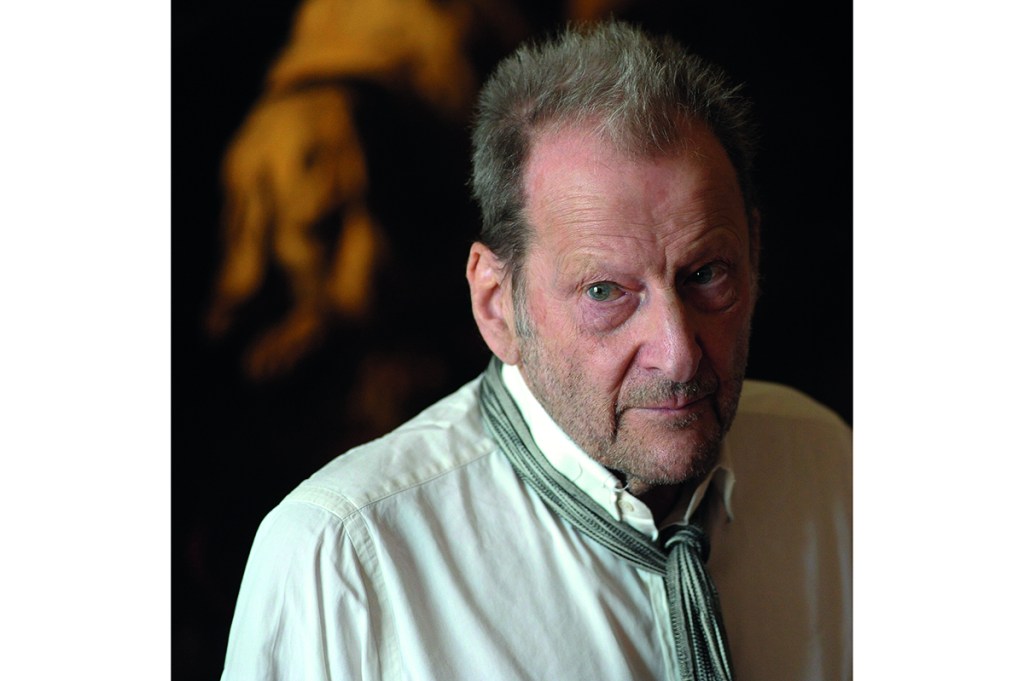Staying with Peregrine Eliot (later 10th Earl of St Germans) at Port Eliot in Cornwall, Lucian Freud remembered that the Eliots ‘ate off solid silver plate, even shepherd’s pie’. In 1968, Freud was having an affair with Perry’s wife Jacquetta. According to her, it was an addiction: ‘Completely hooked, a dreadful drug.’
After two turbulent years, Jacquetta decided to have a baby by Lucian, ideally to be born on his birthday. Her husband agreed to bring up the child as his own, provided the matter was not mentioned again. The laissez aller attitude is partly accounted for (though not by William Feaver) by the 1960s, and the way the young aristocracy embraced the hippy-trippy counterculture. Jacquetta mentions smoking an opium spliff in Paris with Freud. Her analogy — ‘a dreadful drug’ — is indicative. As is her misspelling of ‘pethidine’ (an opioid painkiller administered in childbirth) as ‘pethadone’ — on the analogy of methadone. The son, Freddy, is now a qualified whirling dervish, practicing at Hebden Bridge in Yorkshire. Is there perhaps a (tie-dyed, kohl eyed, henna, joss-stick, Pakistani black) pattern here?
The older aristocracy was equally unconventional. When Freud painted Mary Rose, Lord Beaumont’s wife, her conversation was racy. She disclosed that she had had an affair with Clement Freud, the Liberal party MP and gourmand. Lucian asked how his brother was in the sack. ‘Punctual’ was her laconic, devastating verdict.
Andrew, Duke of Devonshire, the subject of one of Freud’s greatest portraits, fell out bitterly with Freud — because Lucian had dumped Debo, his wife: ‘Andrew liked whores. When a newspaper revealed that he had been involved with a prostitute, the Duke said how lucky he was to be able to afford such treats.’
The aristocracy is different from you and me. Freud’s other brother, Stephen, he told Feaver, was ‘conventional to the point of eccentricity. Golf!’
Nearly all these revelations were transcribed from tapes and daily phone conversations with Freud — for what, it was agreed between biographer and subject, would be the first funny book about art. You can see why, in the year 2000, as the indiscretions multiplied, Freud withdrew his authorization (in a letter with two first-class stamps). He also enclosed a check as compensation to his Boswell — for £1 million, I was told by one of his aggrieved daughters. (Feaver doesn’t specify the amount.)
We can only be glad that, 20 years on, Feaver decided to publish anyway. Otherwise we would never know that Kate Moss thought Marlon Brando had an ‘enormous arse’. (Freud agreed.) Or that, when she was pregnant, she cut her cigarette intake from 80 a day to 20. The maternal instinct at full throttle. Nor would we have a record of Leigh Bowery (a frequent sitter from 1986 till his death from Aids in 1994) as he prepared for his transvestite act at the d’Offay Gallery:
‘Using a special bra he would squeeze his flabby man breasts together for a six-inch cleavage and tuck away his penis and testicles, securing the lot with gaffer tape. He had “Mum” tattooed inside his lower lip.’
You can see why, as the indiscretions multiplied, Freud eventually withdrew his authorization. And now we know the tattoo was paid for by his assistant and co-performer Nicola Bateman, also one of Freud’s models. He entered the Alternative Miss World 1985 as ‘Miss Fuck It’. ‘The climax of a show he had recently done in Amsterdam ended with his squirting an enema at the audience.’ Bowery stole a couple of paintings, which were retrieved at the last minute from his father’s luggage at Heathrow as he was about to return to Australia after Leigh’s funeral.
A rich, gamey biography, then. With some extremely interesting technical information about, for instance, etching, and Freud’s use of Cremnitz white (a banned substance he bought in bulk when it was made illegal). Following Ingres, he mixed charcoal dust in his paint ‘to give it a Paddington tinge’. His pictures were exercises in accretion, very gradually working outwards from the head which was his starting point. This meant that canvases frequently had to be extended — extra strips ‘zig-zag-sewn on enlarged stretchers’, and eventually bolt-ons. When Freud painted the photographer (and failed painter) Bruce Bernard, he noticed his sitter’s hands were bloated (a sign of ill-health), so ‘four inches were added to the canvas to make space for them’. After the 1980s, this becomes a motif: his portrait of the Queen was enlarged to accommodate more diadem; ‘an extra panel added for the top of Paul’s head’ in ‘Two Brothers from Ulster’.
And this pictorial extension is mirrored by Feaver’s narrative, which is pungent and involving, but at the mercy of yet another appetitlich detail that can’t be left out. It ramifies and bolts like a garden going to seed. This volume and the previous one make more than 1,000 pages, and have a cast of thousands. It would have helped had Feaver included an appendix-supplement of brief biographical sketches — as in the ongoing edition of T.S. Eliot’s collected letters. There are lovely Freudian quips here.
Health: ‘This thing in my chest is like a really bad opera. Really boring.’
Sex: ‘“Old people becoming sex maniacs”: who said that? People change. “Dirty bastard” becomes “Hey, he can still do it”.’
On his deathbed: ‘Hello, Jane [Willoughby, a long-standing love]. I’m fashionably thin.’
On the critic Brian Sewell: ‘An arsehole with a bit of rouge on it.’
But now and again, faced with this Knausgaardian compulsive inclusion, this epic of gossip, the artist’s complete asides, you wonder whether certain inclusions have earned their place in the story. Shortly before he died, Freud was on the phone at dawn. He sounded sleepy. ‘What’s the time? I had a dream. Dreamt that I was going to get married.’ Who to? ‘Don’t know really. Rather complicated. Something about the bridge of my nose.’
Not exactly a rival to Martin Luther King. If you want a cogent, intelligible account of Freud’s life, less gorgeously cluttered but not without its own juicy bits, you need Geordie Greig’s Breakfast with Lucian — essential for orientation — which I found myself consulting as I read Feaver. For instance, there is a problem with the role of Susanna Chancellor in Freud’s life. She was long-lasting, loyal and beloved. But she comes to us quasi-pixelated in this account. Greig tells us in a brisk page and a half that she was a Debenham (the department store), married to Alexander Chancellor, the journalist and editor of The Spectator from 1975 to 1984. She refused to be painted nude. Her husband was carrying on with a 28-year-old journalist, Emily Bearn. Susanna fell out with Freud when he began a relationship with Emily Bearn. Bearn and Freud split, and Bearn went back to Alexander, by whom she then had a child. The Chancellors never divorced. All this is in Feaver’s biography but widely scattered — a DIY jigsaw for the reader. An early overview is broad and vague, fundamentally an NDA:
‘For years there had been fallow spells, during which the day-to-day relationship lapsed, and there were to be periods of reproach, each ending with the resumption of sittings and paintings of unparalleled warmth and liveliness.’
Was painting all that was resumed? Chris Bramham, a young painter whom Freud helped, is quoted: ‘Lucian adored her and I think wanted to marry.’ Bramham, however, is a walk-on part, not an intimate:
‘She did not like him going off the lead when she went off for months in Italy to her big house in Tuscany. Lucian said she wanted him to be monogamous. Well, tell a dog to be vegan.’
It was Susanna Chancellor who initiated Freud into whippets. At an uncomfortable dinner with Charles Saatchi, who wants the secrets of successful philandering, Freud replies: ‘I have been in love with one woman for some years and she has not allowed sex.’ Is this Susanna Chancellor?
Feaver doesn’t hazard a guess as to any possible identity. Maybe his reticence is strategic. Maybe he just doesn’t know. There were froideurs for two years, but when they recommenced, on what footing was their relationship? Sexual? Did Susanna learn to care and not to care? Was she stalwart, committed and, in the end, maternal? In Freud’s letter to Feaver, revoking permission, these telling words occur: ‘talking to you very freely about private matters (nearly everything)’. In this biography of revelations, some things remain opaque.
This article was originally published in The Spectator’s January 2021 US edition.


















